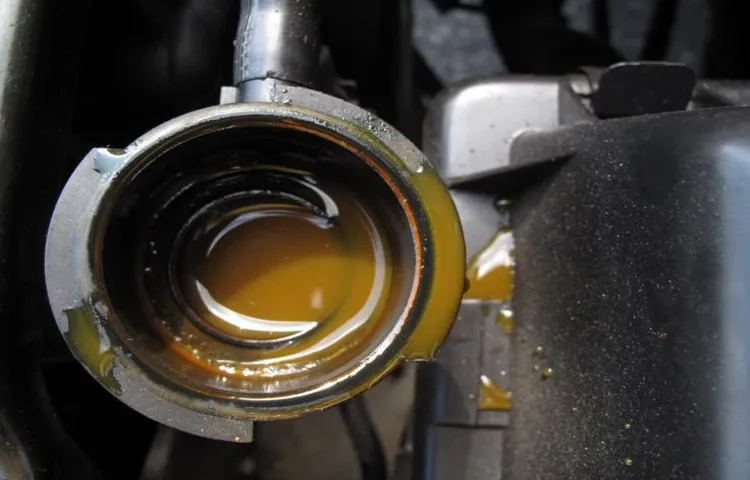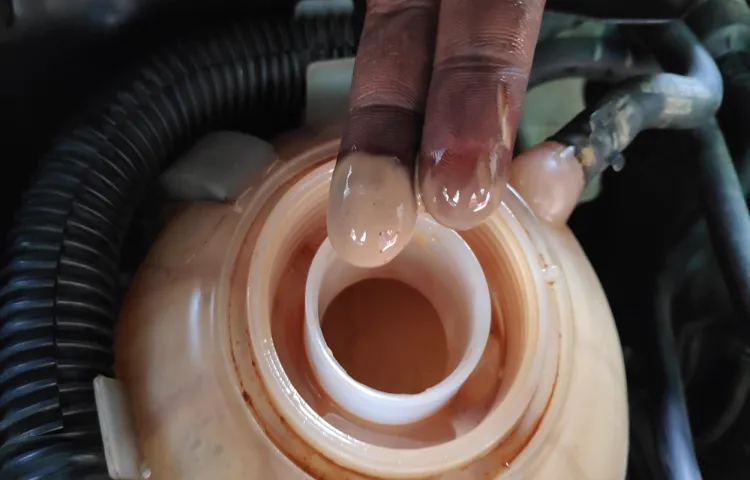If you’re a vehicle owner or a mechanic, one thing you never want to find in your engine is oil mixed with coolant. This can signal a serious problem that needs attention immediately. But how do you know if your oil and coolant are mixing? The first sign is often a murky liquid in your coolant reservoir that resembles a chocolate milkshake.
In this blog post, we’ll discuss the causes of oil mixed with coolant and what to look for. Trust us, you don’t want to ignore this issue. It’s time to get under the hood and investigate.
Table of Contents
Understanding Oil and Coolant in Your Engine
If you’ve ever noticed that your engine oil and coolant are mixed, it could be an indication that something is wrong with your engine. When oil and coolant mix, it creates a sludge-like substance that can cause significant damage to your engine if left unchecked. The color of this mixture can vary depending on the type of oil and coolant being used, but it typically looks like a thick, frothy, and muddy substance.
It’s essential to address this issue promptly to prevent further damage to your engine. A professional mechanic will be able to diagnose the cause of the oil and coolant mixing and provide the necessary repairs or replacements. Remember, regularly checking the condition of your engine oil and coolant could save you from major engine repairs down the road.
How Oil and Coolant Normally Behave
When it comes to engine maintenance, knowing how oil and coolant normally behave in your engine is essential. Oil is responsible for lubricating the moving parts within the engine while coolant regulates the temperature of the engine. Oil will usually flow through filters and galleries before being pumped by the oil pump into the engine’s moving parts.
If the oil levels are low, this can cause friction and damage to the engine. Coolant, on the other hand, flows through the engine’s cooling system and is cooled down by the radiator before being recirculated. The coolant should always be at an appropriate level to prevent the engine from overheating.
Understanding how these fluids work in your engine and keeping them at proper levels is crucial in maintaining the health and longevity of your engine.

Common Symptoms of Oil Mixed with Coolant
When it comes to keeping your engine running smoothly, understanding the difference between oil and coolant is essential. Oil lubricates the engine and helps reduce friction, while coolant helps regulate the engine’s temperature. However, a common problem occurs when oil and coolant mix together, causing a host of issues.
One of the most obvious symptoms of oil mixed with coolant is a milky appearance in the engine oil or coolant. This is caused by the oil and coolant emulsifying and forming a thick, creamy substance that can clog up vital engine components. Other symptoms can include increased engine temperature, decreased oil pressure, and a sweet smell coming from the exhaust.
It’s essential to identify and address this issue promptly to prevent further engine damage. So, if you notice any of these symptoms, it’s best to take your vehicle to a mechanic as soon as possible to get it checked out. Remember, a little prevention can go a long way in keeping your engine running smoothly and efficiently!
Identifying Oil Mixed with Coolant
If you suspect oil is mixed with your engine’s coolant, it’s important to identify it right away. Visually inspecting the coolant reservoir can reveal a mixture of oil and coolant that resembles a creamy or muddy substance. It may also appear to be slightly thicker than regular coolant and have a noticeable odor.
Another sign of oil mixing with coolant is a frothy or bubbly appearance in the coolant overflow tank. You may also notice a milky brown color in your engine’s oil, which is an indication of contamination with coolant. If you notice any of these signs, it’s important to have your vehicle inspected by a professional mechanic to determine the root cause and prevent further damage to your engine.
Visually Inspecting Your Engine
When inspecting your engine, it’s important to keep an eye out for any signs that your oil is mixed with coolant. This could indicate a serious problem with your engine, and catching it early could save you a lot of hassle and expense down the line. The easiest way to check for this is to pop open your radiator cap and take a look at the coolant inside.
If it looks oily or sludgy, that’s a pretty good indication that there’s some sort of oil contamination going on. Additionally, you might notice that your oil is a milky white color or that your engine is running hot or overheating. In any of these cases, it’s important to take your car to a mechanic right away to identify and fix the problem before it causes any serious damage.
The keyword used organically: engine inspection, oil mixed with coolant.
Performing a Chemical Test
Performing a chemical test is a crucial step in identifying if oil is mixed with coolant in your car’s engine. One way to do this is by using a test strip that changes color based on the presence of oil. Simply dip the strip in the coolant and compare the color to the chart provided to determine the level of oil contamination.
Another method is to use a refractometer which measures the coolant’s refractive index. If there is a sudden drop in the index, it indicates oil contamination. These tests help prevent further damage to your engine, as oil in the coolant can cause corrosion and overheating.
By identifying the problem early on, you can save yourself from costly repairs and ensure the longevity of your vehicle.
Using a Diagnostic Tool
Identifying oil mixed with coolant can be a daunting task for any car owner. However, using a diagnostic tool can make the process much easier and more accurate. These tools are designed to detect the presence of oil in the coolant and can also help pinpoint the exact location of the leak.
When oil mixes with coolant, it forms a milky white substance that is often visible in the radiator or overflow tank. This can cause serious damage to your engine if left untreated, so it’s important to catch it early and take action. By using a diagnostic tool, you can quickly and easily identify the presence of oil in your coolant and take the necessary steps to fix the issue.
With the right tools and knowledge, you can keep your car running smoothly and avoid costly repairs down the line.
Dealing with Oil Mixed with Coolant
If you suspect that your car’s engine oil is mixed with coolant, there are a few telltale signs to look out for. Firstly, check the color and consistency of the fluids. Oil mixed with coolant often appears milky and has a sludgy texture.
This can be due to the two substances not mixing, causing a separation that creates an emulsion that appears frothy or creamy in color. Secondly, keep an eye on your car’s temperature gauge as overheating can occur when there is a mixture of oil and coolant in the engine. Other symptoms include white smoke coming from the exhaust, a sweet smell from the engine, or a loss of power.
It’s essential to address this issue promptly, as leaving it can cause severe engine damage and potentially expensive repairs. Have a professional mechanic inspect your vehicle and diagnose the issue, as there are various causes for this problem. Overall, keeping an eye on your car’s fluids and addressing any abnormalities immediately can prevent more significant problems in the long run.
Causes of Oil Mixed with Coolant
Dealing with Oil Mixed with Coolant If you notice that your vehicle’s coolant has changed from its usual color to a milky white or foamy consistency, it is an indication that your engine oil has mixed with your coolant. This can be caused by several factors: a blown head gasket, a cracked engine block, a damaged cylinder head, or a warped engine head. When oil mixes with coolant, it can cause damage to your engine and reduce its efficiency.
Consequently, it is essential to have it checked by a professional mechanic as soon as possible. If ignored, the damage may become irreversible, and you may end up with a blown engine. To deal with oil mixed with coolant, take your vehicle to a reputable repair shop to diagnose and fix the problem.
They will conduct a thorough check-up to identify the cause and perform repairs necessary to get your vehicle back to optimal performance. Remember to also flush your cooling system at least once a year to prevent contamination and prolong your car’s life.
Steps to Fixing the Problem
Dealing with oil mixed with coolant in your vehicle can be a frustrating problem, but there are steps you can take to fix it. Firstly, it’s essential to identify the source of the issue. This could be a blown head gasket, a cracked engine block, or a damaged cylinder head.
Once you’ve pinpointed the problem, you’ll need to remove the oil and coolant from the system and replace them with fresh fluids. It’s crucial to flush out the entire system thoroughly to ensure all contaminants are removed. Next, you’ll need to fix or replace the faulty component causing the mix-up.
This might require professional assistance if you’re not experienced in engine repair. It’s essential to resolve the issue as quickly as possible because driving with contaminated fluids can lead to significant damage to your vehicle’s engine. With the right diagnosis and corrective action, you can get your car running smoothly again.
Preventing Oil Mixed with Coolant
If you notice oil mixed with coolant in your vehicle, it can indicate a serious problem that needs to be addressed immediately. One way to prevent this issue is by regularly checking your engine’s oil and coolant levels and ensuring they are at the recommended levels. Another way to prevent this issue is by keeping your engine’s cooling system clean and free of debris.
Additionally, you should have your vehicle serviced regularly by a qualified mechanic to check for any signs of leaks or damage. Oil mixed with coolant can appear as a milky or foamy substance in your engine’s oil or coolant reservoir. If you notice this, do not continue to drive your vehicle as it can result in severe engine damage.
Address the issue promptly by seeking the assistance of a professional mechanic. By taking preventative measures, you can avoid the costly and potentially dangerous issue of oil mixed with coolant in your vehicle.
Routine Maintenance and Inspections
Prevent oil mixed with coolant during routine maintenance and inspections to avoid engine damage. Oil mixed with coolant can cause a lot of problems, including overheating, corrosion, and engine damage. There are a few things you can do to prevent this from happening.
First, check the oil and coolant levels regularly and ensure that they are at the right levels. Additionally, make sure to change your oil and coolant according to the recommended schedule. Using high-quality oil and coolant can also help prevent contamination or mixing.
During routine inspections, look for signs of oil mixing with coolant, such as milky-colored oil or coolant, and coolant leaks. If you detect any of these issues, take your vehicle to a professional mechanic for further inspection and repairs. Don’t ignore the problem, as it can lead to costly engine damage and repairs.
By taking preventative measures and catching any issues early on, you can avoid mixing oil and coolant altogether.
Using Quality Products and Materials
When it comes to preventing oil mixed with coolant, using quality products and materials is crucial. This can be achieved by ensuring that all the parts and components used in the engine are made of the best materials possible. The use of substandard products and materials can result in oil leaking into the coolant system or coolant leaking into the oil system, causing serious damage to the engine.
To prevent this, it is important to use high-quality gaskets, seals, and other engine components that are designed to withstand high temperatures and pressure. These products are specifically designed to prevent leaks and ensure that the oil and coolant systems are kept separate. Another way to prevent oil mixed with coolant is by ensuring that the engine’s cooling system is working properly.
Regular maintenance and checks can help identify any issues before they become major problems, such as leaks or clogs. Using quality products and materials not only prevents oil mixed with coolant but also ensures the engine’s longevity. By investing in high-quality products, you can avoid costly repairs down the line and enjoy a smoother, more efficient running engine.
Remember, quality always pays off in the long run.
Following Manufacturer Guidelines
Preventing Oil Mixed with Coolant: Follow Manufacturer Guidelines If you own a car, then you know how important it is to keep your engine running in good condition. One of the critical aspects of engine maintenance is ensuring that your coolant and oil don’t mix. A mixture of coolant and oil can cause serious performance issues, costly repairs, and worse, engine failure.
The good news is, you can prevent oil mixed with coolant if you follow the manufacturer’s guidelines. The manufacturer’s guidelines are designed to keep your engine running at its peak performance. In most car manuals, you will find information about the recommended type of oil and coolant for your engine.
It’s essential to use quality products recommended by the manufacturer to prevent any issues from occurring. Another way to prevent oil mixed with coolant is to check your engine regularly. You can do this by inspecting the oil and coolant levels regularly.
If you notice that either the oil or the coolant level is too high or too low, then that is an indication that something is wrong. It could mean that there is a leak or some other issue that needs to be addressed immediately. Lastly, make sure to flush your engine coolant and change your oil regularly as recommended by the manufacturer.
Doing so will help prevent buildup and contamination, which can lead to serious engine issues. In summary, following the manufacturer’s guidelines is an essential step in preventing oil mixed with coolant. It’s vital to use the recommended products, check your engine regularly, and flush your engine coolant and change your oil as recommended.
By doing so, you can ensure that your engine is running smoothly and avoid costly repairs down the line.
Conclusion
Oil mixed with coolant looks like a bad romance between an oil slick and a bright antifreeze. It’s a murky mess that no engine wants to be a part of. Just like how oil and water don’t mix, oil and coolant should never cross paths.
It’s like one of those odd couples that just doesn’t work out – they may look okay together but under the surface, it’s a disaster waiting to happen. So to sum it up, seeing oil mixed with coolant in your engine is a red flag that should not be ignored.”
FAQs
1. What are the possible causes of oil mixed with coolant in a car engine? – Oil cooler failure – Head gasket failure – Cracked engine block – Failed transmission cooler 2. How can you identify if oil is mixed with coolant? – Milky and frothy oil under the oil cap – White smoke coming from the exhaust pipe – Coolant loss with no apparent leak – Overheating engine 3. How dangerous is driving a car with oil mixed with coolant? – It can cause severe damage to the engine and components – It can lead to engine failure – It can cause a fire hazard – It can be dangerous to the driver and passengers 4. How much does it cost to fix oil mixed with coolant? – The cost can range from a few hundred dollars to several thousand – It depends on the root cause of the problem – Labor costs will also vary depending on the auto repair shop 5. Can oil mixed with coolant cause damage to the transmission? – Yes, it can damage transmission components – The coolant can mix with the transmission fluid, leading to reduced lubrication and overheating – It can also lead to transmission failure 6. Can DIY repairs fix oil mixed with coolant? – It depends on the cause of the issue and the extent of the damage – Some minor issues can be fixed with DIY repairs, but major issues require professional expertise – Attempting DIY repairs without proper knowledge and tools can cause further damage 7. How long can you drive with oil mixed with coolant? – It is not safe to drive a car with oil mixed with coolant – It is recommended to have the car towed to an auto repair shop immediately – Continuing to drive can cause irreversible damage to the engine and other components.



